Ballybunion Golf Club (Old Course)
County Kerry, IRELAND
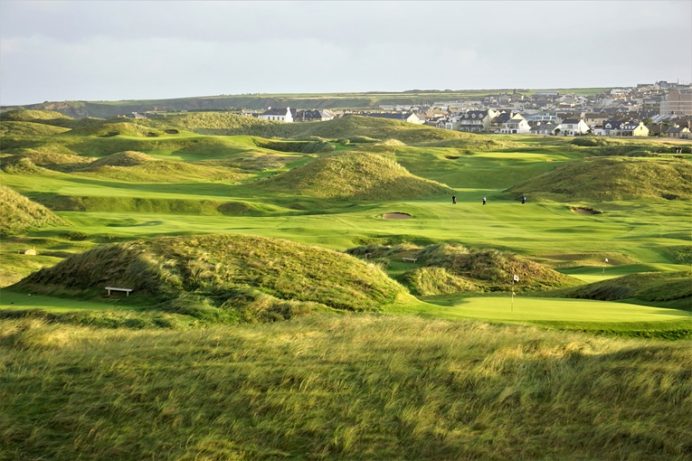
Ballybunion’s sumptuous dunescape wants for nothing.
Some courses gain fame by association with an architect or by hosting grand events. Ballybunion gained it the old fashioned way: by being awesome.
Like The Country Club in Brookline, Massachusetts, the members deserve credit for much of the course’s backbone with a master architect eventually adding the degree of sophistication that makes the design world class. Holes first appeared in 1893, emanating from the seaside town, which is to say near today’s sixth tee. Initially, people didn’t fawn. Bernard Darwin didn’t even include Ballybunion in his 1910 The Golf Courses of the British Isles. The reason is straightforward: the nine hole course didn’t enter into the property’s most scintillating dunes and Tom Simpson had yet to pay his crucial visit. That soon changed.
By 1927, the course had been expanded to eighteen holes and today’s general routing was in place, though the sequence still had the golf starting at the sixth and finishing with two par 5s, today’s fourth and fifth holes. When Tom Simpson arrived in 1936, he offered one major piece of advice: Do not do much, in what was surely a glowing compliment to the work that had been accomplished in the first forty years by the locals. He ultimately issued a six page report, which went hole by hole with his thoughts and recommendations. In the case of the seventeenth hole, for instance, he was adamant that the tee be moved but that the green was ‘ideal’ and shouldn’t be touched. Some parts of the report lack clarity because of the frequent use of phrases like ‘as discussed.’ Additionally, even though report called for him to return before the foreman left, it is unclear if Simpson ever did. Regardless, as with Alister MacKenzie in Australia, Simpson imparted sound advice which was acted upon for years after he left. Without question, the locals deserve credit for the in-the-field execution of Simpson’s ideas.
John Molyneaux (Honorary Life Member who knows as much as anybody of the course’s history) states unequivocally, ‘To attribute credit for the evolution of the old course to one architect would be invalid. All the signs are that everything that happened at Ballybunion was piecemeal.’ The result? Ballybunion enjoys its own voice in world golf. At no point does the player feel like he has seen this done before or that he has played a similar design elsewhere. This is as it should be because Ballybunion occupies one of the handful of most magical locations upon which a course has ever been laid out. The northern part toward the town enjoys a clifftop setting with the eleventh hole dropping the player down close to the water. The middle and southern end are renowned for their heaving dunes and rumpled fairways. The Atlantic Ocean borders along the west for over a mile with holes three through five on the inland side along the town.
Additionally, a transformational event occurred within the property during the later half of the nineteenth century. Before there was any thought of golf, the site was used as a sand mine. As Ireland grew, sand became in high demand, especially by farmers. Ballybunion’s dunes were a prime source for the aggregate, not only regionally but throughout the country. Portable tracks were laid down to enable rail cars to reach deep into the property. As pockets of the property were exhausted, the rails were moved. The work emanated from town and there are two known consequences. First, the northern part of the property near town has fewer dunes as a consequence and second, some of the unique landforms that the course enjoys today are a direct result from the sand mining. Hard as it is to believe, the fact that Ballybunion has lesser dunes than it otherwise would have is a good thing. Big dunes are fabulous for photographs but the game of golf at the highest level is distilled down to movement that is human in scale. As we will read later on, a green complex like the ninth became possible from open space having been created on what was once dunes. It is a particularly stunning example of the flexibility that quiet land movement can give to an architect. And to be frank, the lack of quiet moments is one reason that the Cashen Course has never been fully embraced.
Jumping ahead a century and in comes to town Tom Watson with his friend Sandy Tatum. The year was 1981 and Watson had already won two of his five (!) Opens. Watson loved it so much that he immediately walked out for a second 18, alone with his caddy, despite being just off the plane with no sleep, and the Open starting in a few days. Ever since, the ultimate connoisseur of links golf was unstinting in his love and praise of Ballybunion.
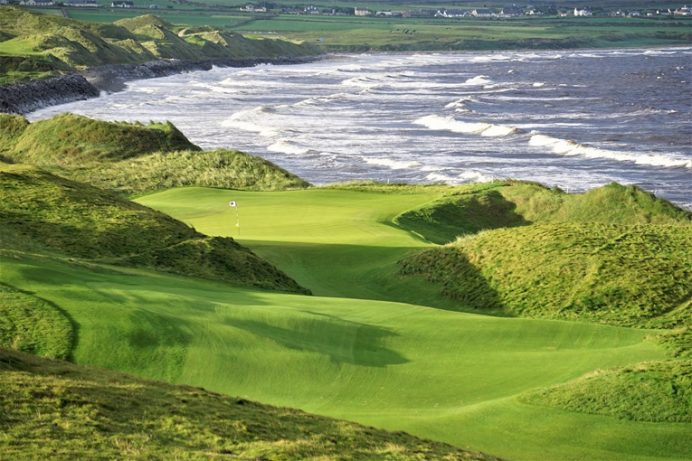
Golf offers few grander moments than the approach to the 11th. Imagine ‘stumbling’ upon this hole in the 1960s before the course had achieved worldwide acclaim. No wonder Herbert Warren Wind was prompted in 1969 to tell the Club Manager, Sean Walsh, that ‘To put it simply, Ballybunion revealed itself to be the finest seaside course I have ever seen.’
When the Morrissetts headed here six years later, we did so with sky high expectations and they were exceeded. Ballybunion soon became a mainstay on any Irish itinerary. For thirty years, Green Keeper Dan Blake worked with a very small crew (imagine maintaining these 135 acres with a crew sometimes of just four men!) and smaller budget. Still, the course rose from obscurity to world renown. Blake became a hugely popular local figure and is now an Honorary Life Member. His retirement in 2014 was well earned.
Nonetheless, during his thirty year tenure, a lot had changed in golf, especially agronomy and therefore, golfers’ expectations. Courtesy mainly of Mike Keiser, many exceptional courses had been built along large bodies of water from the Tasmanian Sea to the Pacific Ocean and nearer by along the Gulf of St. Lawrence off Nova Scotia. These courses enjoy fine fescue fairways, spoiling the discerning golfer who now demands dream golf whereby the agronomics are the equal to the romantic settings. If the playing surfaces aren’t uniform to where they release the ball via fast and firm conditions, then the ability to manufacture shots is undermined. If a patch before a green is sticky rye grass, for instance, then the golf devolves into more of a hit and hope game whereby skill doesn’t necessarily overcome chance. Yet, links golf is superior to all other forms only if a golfer is given realistic options on how to play each shot. How well he thinks and executes determines the outcome, but the underpinning is that all options must be available to him for consideration. The color of the grass is immaterial but bouncy-bounce conditions that release the ball are paramount.
For Ballybunion to retain its stature as one of the world’s elite courses, it had to present itself in such a manner. The variety of grasses that populated the fairways and greens would no longer suffice as the ball didn’t quite release across the playing surfaces as it did at other links. Happily, the club recognized that fact and took a series of bold steps starting in 2014. First, they hired Green Keeper John Bambury, who had just grown in the Trump International Golf Links in Aberdeen, Scotland. In Bambury, a man with local roots, the club knew they had the right man to regrass its poa greens to 100% fescue, no easy chore. Its greens, for which the course is so well known, were digitally scanned before construction commenced. The course closed October, 2015 and re-opened late the following spring with all eighteen greens having been rebuilt with fescue to the exact contours of the old ones. Organic matter was found more than three feet (!) below the surface, including silt, charcoal, clay and even seaweed. Peat was also unearthed and Bambury supposes it could have been used to stabilize the sand from wind events during course construction pre-1900. Finding such inhospitable matter underneath only confirmed the wisdom of the club’s comprehensive actions.
Simultaneously with converting the greens, Bambury reduced the water and fertilizer to the fairways, which had become 40% rye. The entire mission statement was to re-establish the running game to the highest standard possible. Additionally, concrete resin paths were replaced with grass walkways.
By the end of 2019, the hard work was finally paying off and fairways were approaching the stated ideal. The ball is once again scampering about and the design is starting to be experienced in its full glory. Additionally, Bambury is promoting fescue roughs whereby the golfer can relatively quickly locate his wayward ball and advance it a certain degree without undue delay. Bambury notes, ‘We have removed weedgrasses from most of the deep rough and it’s important that when we irrigate fairways, water is not thrown into the deep rough as this would see a return to a thick unplayable sward. Water is used sparingly at Ballybunion. Its primary purpose on fairways is to allow us to use penetrants which change the tension of water in the soil and help drainage. This in turn helps us tilt the balance of soil moisture towards percentages that favour fescue.’
With 40,000 annual rounds, this was no small matter for the club to undertake such drastic steps. Regrassing the greens and their surrounds had a material financial impact but what a relief that the club was willing to make short term sacrifices for the sake of future generations. The club’s actions highlight the often tough choices that come with being a great custodian.
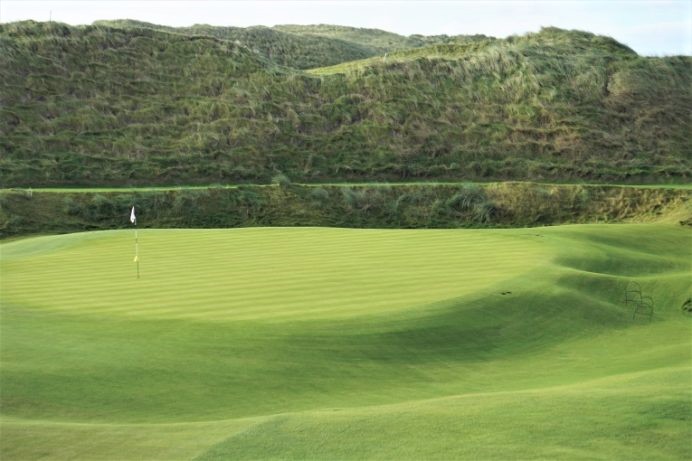
Ballybunion’s 21st century maintenance practices and uniformly tight fescue playing surfaces ensure proper playing conditions. Of all the great links, only St. Andrews uses short grass to such great effect.
As we see below, Ballybunion is too special not to be optimally presented. Now, for the first time in its history, the foundation has been set for Ballybunion to enjoy playing conditions that will both complement and enhance its superb architecture.
Holes to Note
Second hole, 440 yards; Key to Ballybunion’s success is its mix of holes and how they route in and out of the dunes. In the case of the second, the tee ball plays into a field and then the golfer faces a dramatic uphill shot to a cruelly small green. Tom Watson nominated this and the second at Pinehurst No. 2 as his two favorite second holes. At 3,750 square feet, this is the third smallest green on the course and to make matters worse, the front 10% is unpinnable so it really is a beast to hit in regulation. Averaging 5,200 square feet, the greens at Ballybunion are none too big for such a windy location and pressure on one’s short game is guaranteed throughout the round.

This northward view across the property shows the gap in the dunes through which the 2nd plays.
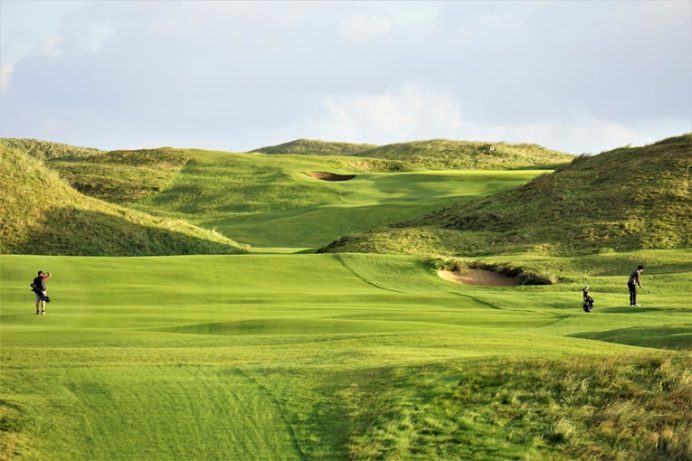
Good luck – the odds for a successful approach from 185 yards to the elevated 2nd green are not in the golfer’s favor.

The golfer’s approach almost surmounted the false front before he watched from the fairway as his ball retreated.
Third hole, 220 yards; Commencing with the downhill tee ball at the first and finishing with the uphill approach over a great hazard at the Home hole, golf at Ballybunion is nothing if not a study in topography. The constant alteration between uphill and downhill shots and how they pair together helps keep the golfer engaged and slightly off-balance. For instance, the uphill approach at two is followed by this downhill one shotter and the two shots couldn’t be more different. At the second, the player has to carry his approach well onto the green or risk seeing his ball depart off the front. At the very next hole, to fly one’s ball directly onto the putting surface is a guaranteed mistake. Far wiser to use the 17 yard area of short grass before the green that Simpson suggested to deaden one’s tee ball and then have it trundle onto the putting surface. The shifting asks of the player (e.g. the downhill approach at 11 – the steeply uphill approach at 12, the downhill approach at 15 – the uphill approach at 16) are questions never posed by sites with more mundane landforms.
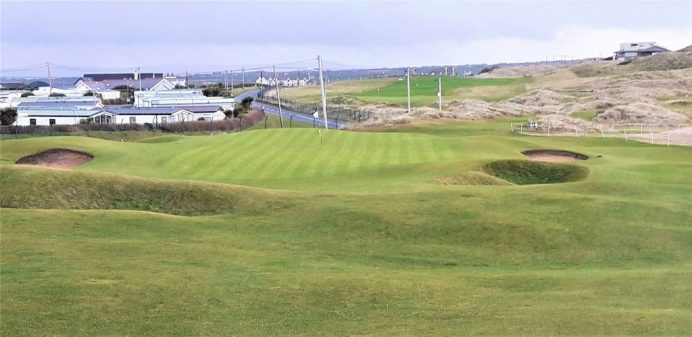
Can the golfer drop his tee ball over the depression in the foreground that Simpson suggested and have his ball release onto the open green? Complicating matters, the hole is often played in a cross breeze.
Sixth hole, 385 yards; The sixth kicks off a peerless run of twelve holes and is the first of four bunkerless holes. Every architect should study this green and the assumption has – naturally – often been that this was Simpson’s work. Yet, it was the handiwork of the summer professional-in-residence Moses O’Neill several years before Simpson’s visit (albeit as the first green). Part of its magic is that it lends the sixth – the only hole on the course with less than ten feet in elevation change from tee to green – superlative golf qualities. O’Neill’s idea to move the green complex from the hollow to the plateau shows how thoughtful architecture can provide great playing interest but it also makes you wonder why more architects don’t employ a similar stratagem more often. After all, the green complex challenges every level player, involves no upkeep of bunkers, and rests peacefully on the land. It’s ideal in all respects so … why don’t we see a version more often?! Member Neil Regan, having battled the hole hundreds of times, states, ‘ The short second shot to this bunkerless green tests your skill in the wind more than any other shot on a course where the wind is king.’ It also provides a quiet moment visually in the round. With such a rambunctious landscape, the risk is that the golfer will become desensitized at some point to the wildly undulating topography. The stretch from four to seven helps ensure that this doesn’t happen.
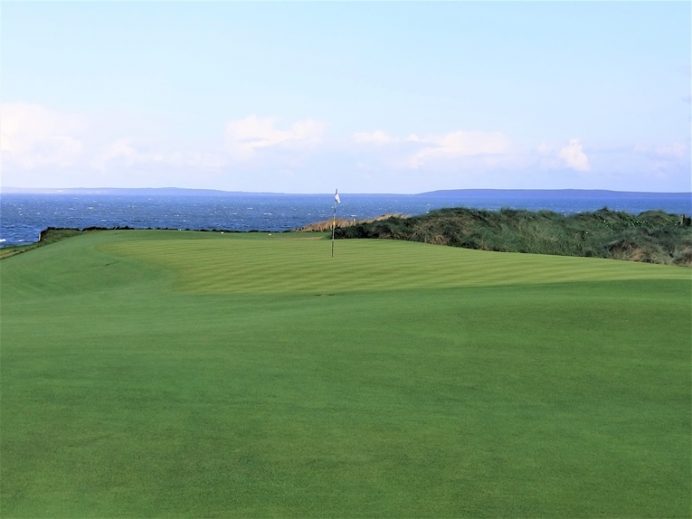
A false front/side left and another one …
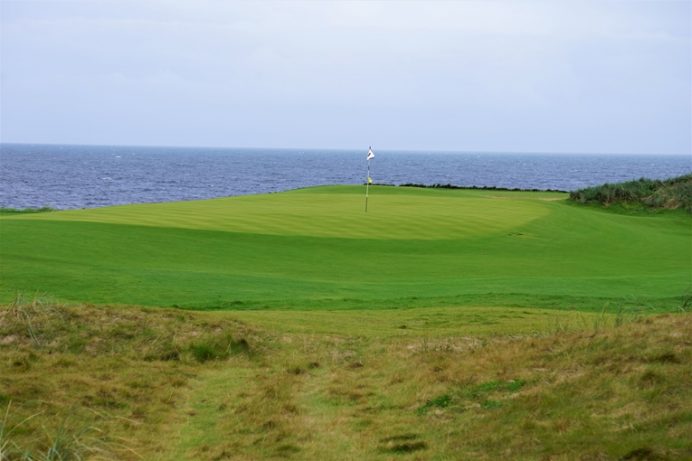
… right makes the innocuous looking 5,725 square foot 6th green an elusive target.
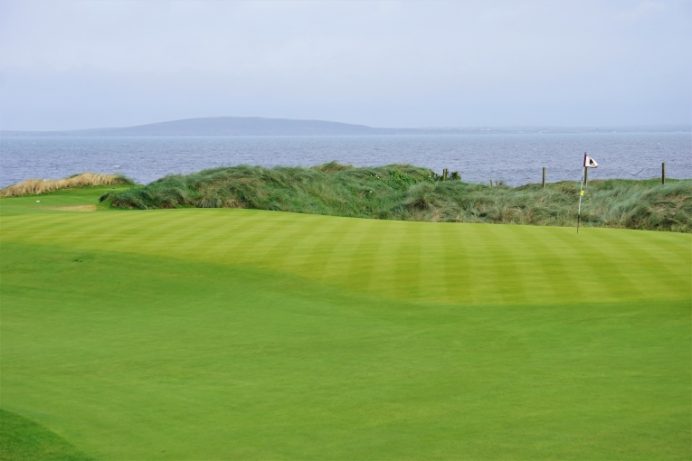
Will a current architect please build something similar?
Seventh hole, 425 yards; Simpson urged that this dogleg left be altered by moving the inland green site to a location flush along the cliffline. Simpson’s green site actually protruded more to the right (!) than today’s one but that bit of clifftop land was lost forever during an epic evening storm in February, 1977. Nonetheless, today’s green location nestles in well to the dunescape. Despite the playing corridor being straight, interesting playing angles exist, courtesy of a ridge line some 130 yards short left of the green.
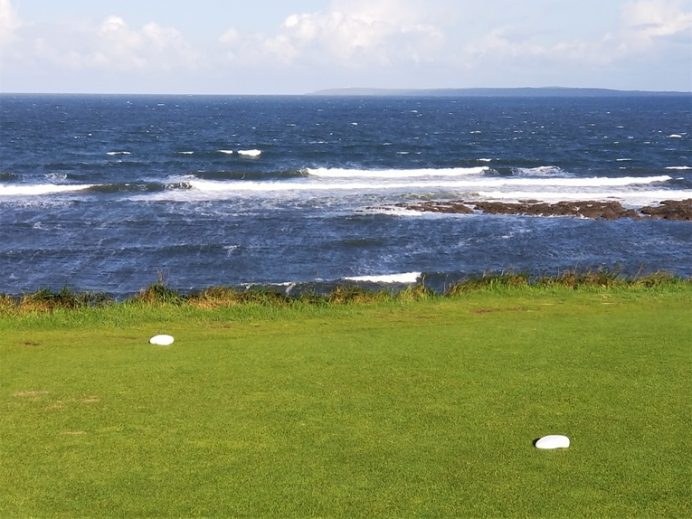
The golfer briefly escapes the dunes, only to find himself at the cliff’s edge for the tee ball at 7.
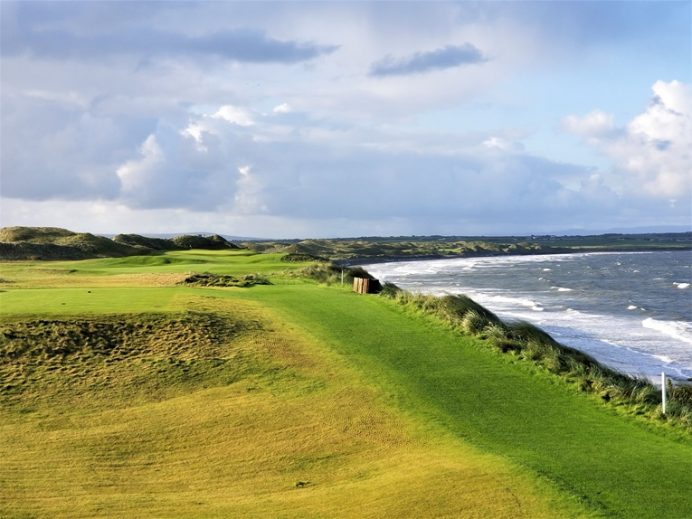
Various factors influence play on this straight hole. Generally the wind buffets from the right and actually assists in hindering shots from straying too far right. Still, ‘I lost my ball in the sea’ is a more common saying at Ballybunion than just about any other links.

This ridge line doesn’t impact play from ~175 yards back of the green, but …
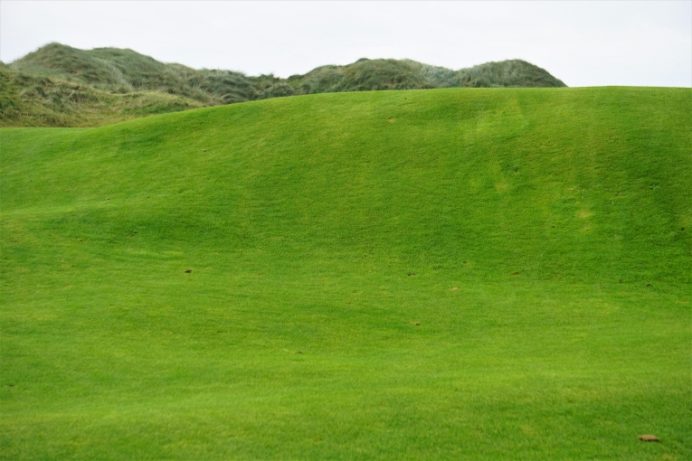
… it most definitely does should the golfer drive indiscriminately close to it.
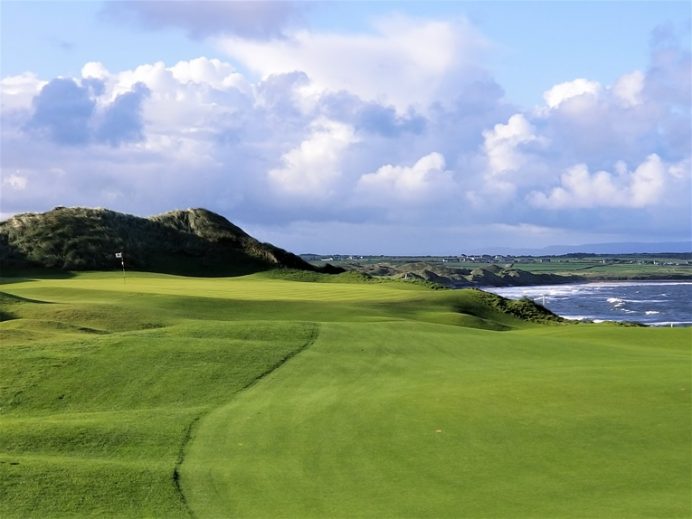
The flag highlights the typical wind and this left hole location is appreciably easier to which to get close than those along the right.
Eighth hole, 155 yards; A beloved short hole, the eighth epitomizes what short grass can mean to a links as the slender green is bedeviling. At 3,250 square feet, it represents the day’s smallest target. Two greenside bunkers left push the visiting golfer right but that’s where the problem lies: any ball hit along the green’s soft right side can take the bank and be sweep well away. Those familiar with Pinehurst No. 2 know the helpless feeling as well as the conundrum tight short grass poses for the recovery. Add in wind as a variable and let the games begin, realizing that the elevated cliffside tee marks the course’s high point, meaning there is no place to hide and that ‘wind’ in Pinehurst is known as a calm day at Ballybunion.

The pronounced slope left of the green means that the left 20% of the putting surface can’t be used for hole locations. Yet, a miss right is like opening up Pandora’s Box. In 2013, the mixes of grasses held the ball closer to the green while today’s fescue surface does not. Recently, the club also shrewdly enhanced the mounds behind the green to minimize the view of the distant homes.
Ninth hole, 460 yards; Another masterful Simpson recommendation was this green complex, whose putting surface starts at fairway level, climbs a dramatic false front, before plateauing for the back two thirds. Though the green measures a reasonable 5,520 square feet, only the back 3,640 square feet can be used for hole locations. Put another way, that makes this the smallest effective target apart from the greens at the two short par three holes (eight and fourteen). Complain, complain, whine, whine – This is hardly a fair target for a hole of this length, mutters the disgruntled visitor! The fact that there are no bunkers is of no consolation. Though a dune separates this hole from the coast, the approach is one of the day’s most striking shots, highlighting what someone like Simpson can mean to a course’s evolution. The sixth, seventh, eighth and ninth green complexes – can you name four better ones in a row on any links? Maybe eleven through fourteen at The Old Course at St. Andrews, twelve through fifteen at Machrihanish and thirteen through sixteen at North Berwick are comparable but that is a very short list.
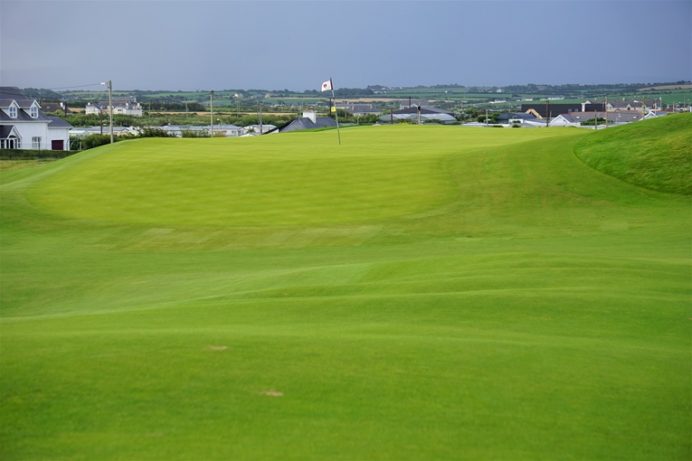
The last thing Ballybunion represents is target golf. Rather, the golfer has to look 5 or 10 or 15 yards shy of the green and manufacture some sort of running approach shot. This is links golf of the highest order.
continued >>>
Ballybunion Golf Club (Old Course)
County Kerry, IRELAND
Tenth hole, 355 yards; The tenth heads the golfer back to the coastline in grand fashion. Just as the Old Trooper might hope, the visuals off the tee create uncertainty. Wonderfully broken ground separates the tee and fairway and then the fairway crests a ridge and – disappears! Trust in one’s swing is paramount in moments like this where the architect(s) doesn’t pander to the golfer with comforting features and aiming marks. Just the opposite, the land is the star, which sets the stage for a classic man vs nature confrontation. This is the second largest green on the course, so be sure to note the day’s hole location when on the nearby eighth tee. In particular, back right offers one of the course’s trickier hole locations to access.
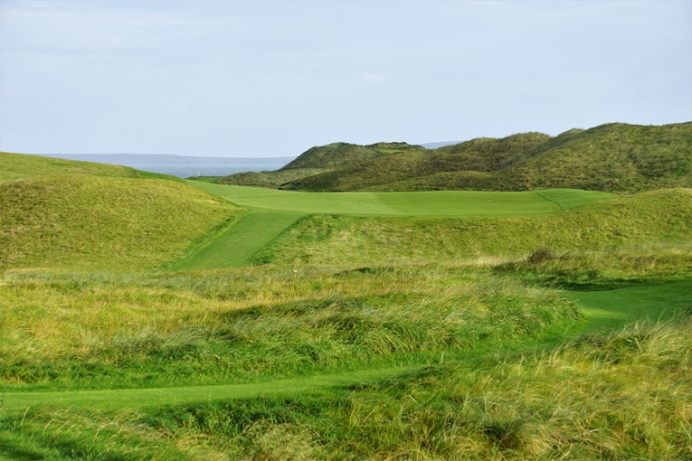
No need to doll up the view from the 10th tee with manmade features.
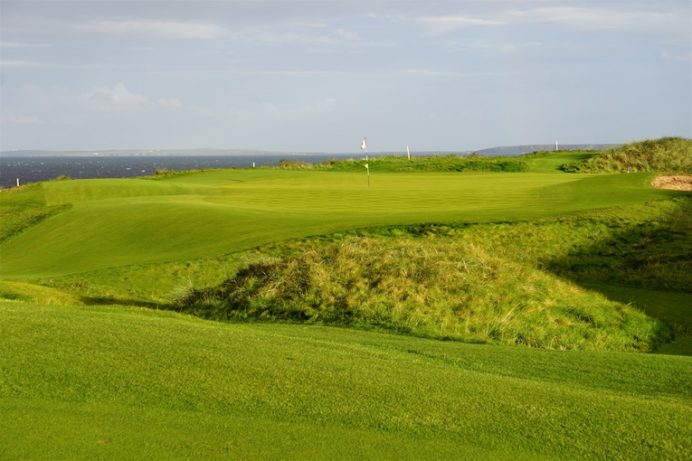
One unique feature at Ballybunion is that the golfer hits five shots with the Atlantic serving as the backdrop, namely the approach here, the 6th, 11th, 15th and the tee ball at the 17th. Most links feature holes that run parallel to the coastline as that’s what the dunelines dictate. Not here.
Eleventh hole, 470 yards; In the first eleven holes, the golfer faces four brute two shotters: the second, seventh, ninth, and here. Let’s think about the four holes and the diversity they represent: the second with its steeply uphill approach to a domed green, the flattish seventh along the cliff, the ninth to a vexing green in a field, and here, whose fairway cascades downhill … then downhill … then downhill some more (!) with the ocean as the backdrop. For sheer diversity, the author struggles to think of any course with such variety in its long two shot holes. The eleventh is the most famous of the bunch and if you have ever seen a picture of golf in Ireland, it likely was of this hole. Given the scale of the dunes, there is nothing quite like it in either Scotland or England. The phrase ‘all-world’ is grotesquely overused but what a thrill to come across a situation where it is apt. Does any hole represent a country better by inspiring visitors to come?
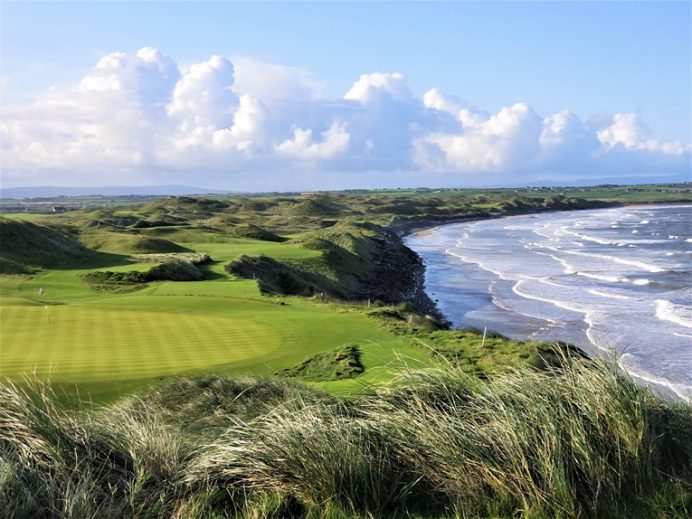
The back marker that turns 11 into a 470 yard beast is on this side of the 10th green, just beyond the marram grass. The right center of the fairway affords the best view of the putting surface for one’s approach. Too far left off the tee and the approach becomes blind.
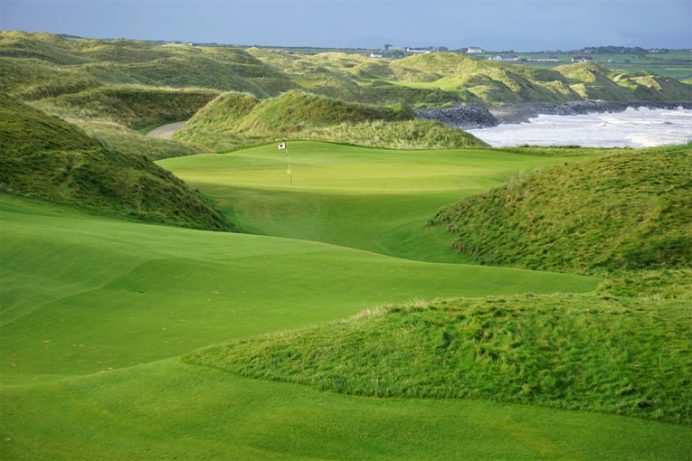
Along with 8 at Pebble Beach and 17 at St. Andrews, the approach to 11 at Ballybunion is as satisfying to execute as any in the sport.
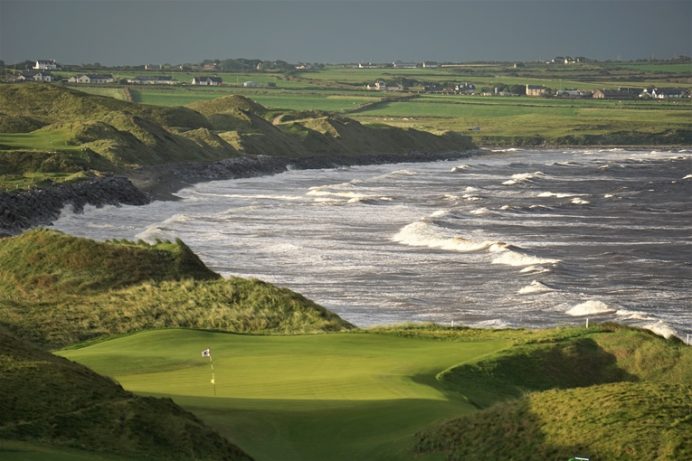
Forget the sunshine bathing the far dunes in the photograph one above; a round at Ballybunion is even more dramatic with an approaching storm.
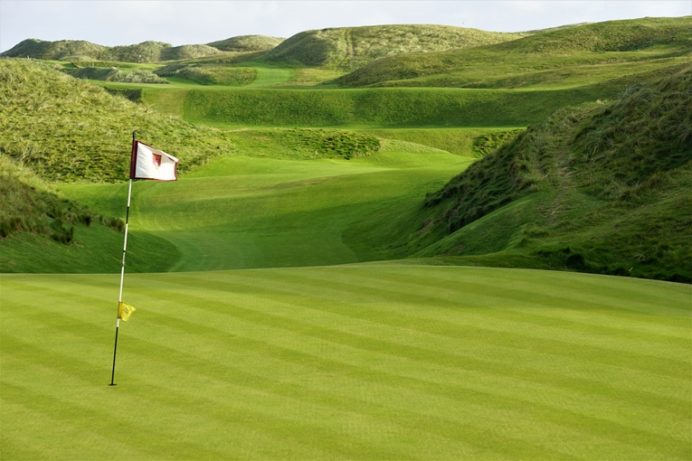
Looking back up toward whence the journey started, would any modern architect have the guts/wisdom to build this unconventional hole today?
Twelfth hole, 210 yards; Apparently, this ledge green was put into use in the mid-1920s. For those that play with hickory clubs, it is indeed a daunting task to think about tackling this hole with such implements back in the day. Even with a state-of-the-art hybrid, the golfer feels outmatched as he looks up the hill at the long narrow green. With no run-up option available on a hole of this length, it’s certainly an atypical links hole. Be that as it may, the onus remains squarely on the player to sort something out, including using the bank left of the green to help brake the tee ball. The twelfth is a reminder that a player’s game needs to fit the course as opposed to the other way around.
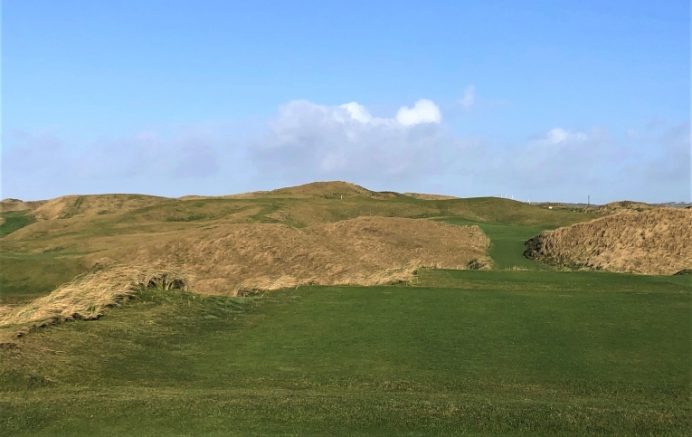
As seen from the tee, the shelf twelfth green is to the right of the white stake in the distance. On this cold winter’s day with no flag in, the golfer’s eyes are free to roam and appreciate the unique landscape.
Thirteenth hole, 500 yards; At this point, the golfer might be a bit battered and bruised, especially after the last four holes. Don’t despair – a string of very interesting 1/2 par holes ensue including a pair of reachable par fives starting with this one. The downhill drive tantalizes and is arguably one of the most important shots of the day as a good one brings the green in reach with a mid-iron. The hole’s defense lies in its captivating green complex, which sure enough, Simpson had a hand in. He suggested that the 1926 green be repositioned away from the burn and moved 80 yards back and to the left atop a small dune. The tiger can quickly go from a mid iron second to an extremely delicate recovery shot for his fourth!
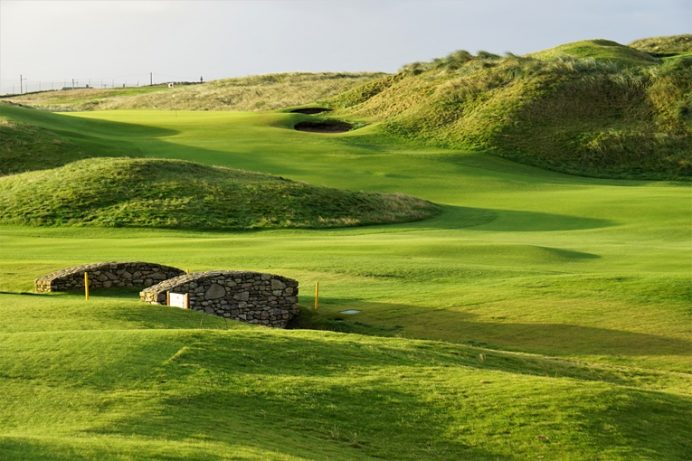
The original green was right of today’s bridge that crosses the burn. The club carried out Simpson’s recommendation to perfection with today’s knob green featuring a sharp, thirteen foot fall-off left and over.
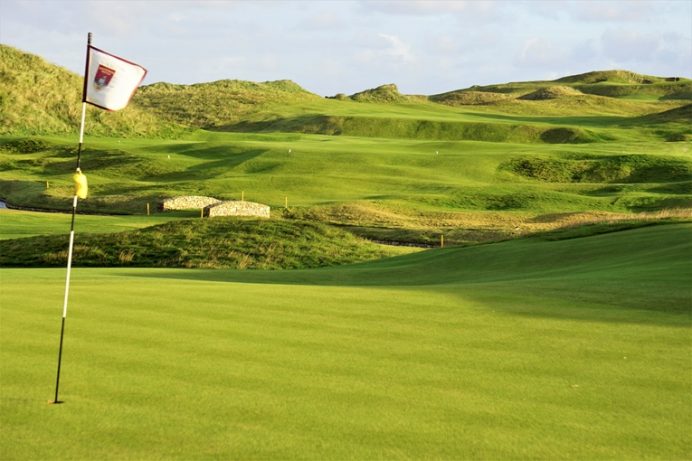
Similar to the 11th, the golfer can’t help but look back up the fairway afterwards and appreciate the unique landforms. Well struck tee balls gain an extra 30 to 60 yards of roll at both holes.
Fourteenth hole, 130 yards; The second nine at Ballybunion ranks with the best sides in world golf courtesy of its plethora of standout holes. This short one shotter understandably gets lost in the shuffle from time to time but don’t be fooled by its modest length. Akin to the playing strategy at 17 at TPC-Sawgrass, don’t even look at the flag; just play for the middle and be content with what will be a short-ish birdie putt.
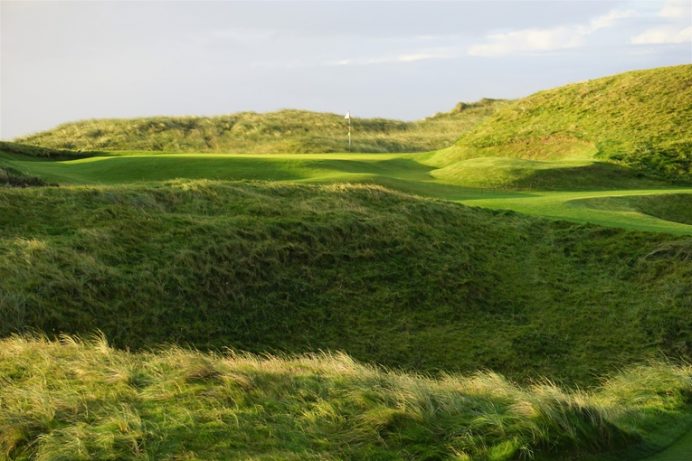
Hoisting a short iron shot into the air on any windy links contains its own set of challenges, especially here …
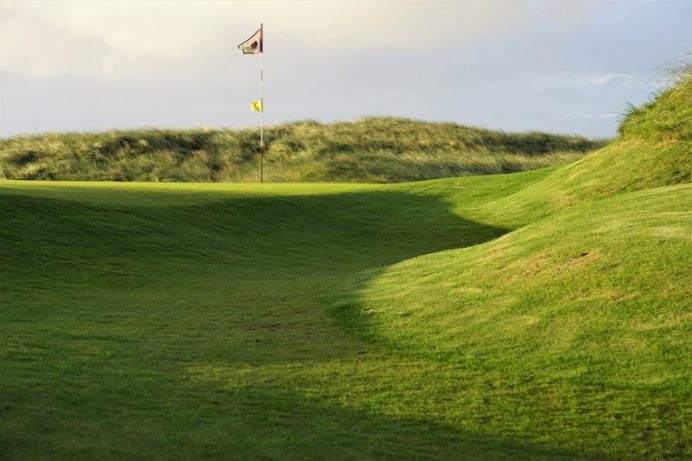
… where the tiny, 3,300 square foot green does nothing but shed balls blown slightly off line.
Fifteenth hole, 210 yards; If the eleventh isn’t the poster for Irish golf, then this one-shotter surely is. Fourteen and fifteen might not quite be the match for fifteen-sixteen at Cypress Point but they are close. Though a two tiered green is generally considered a modern feature, this one has been in play for close to a century. At 5,040 square feet, the putting green is actually smaller than the course’s average green size. Yet, that’s a theme played out several times at Ballybunion Old: the longer the approach, the smaller the target. Add in the monster tier in the middle, and the effective target seems tiny indeed.
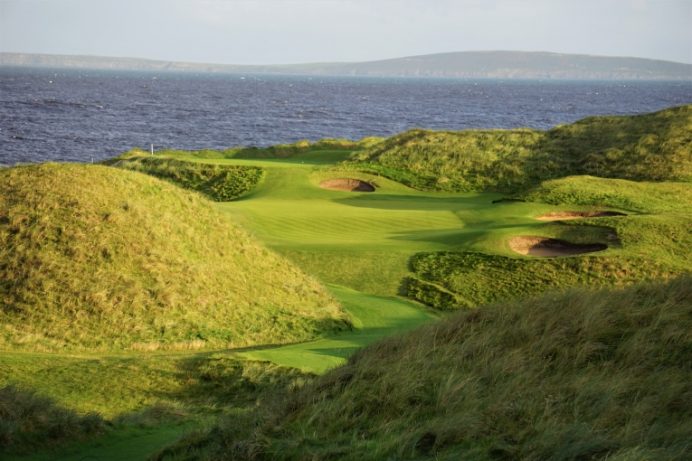
In a neat twist, several of the longest approach shots at Ballybunion are also among the course’s most inspiring. Above is the incomparable one shot fifteenth, as seen very early in the morning before the flag was put in.
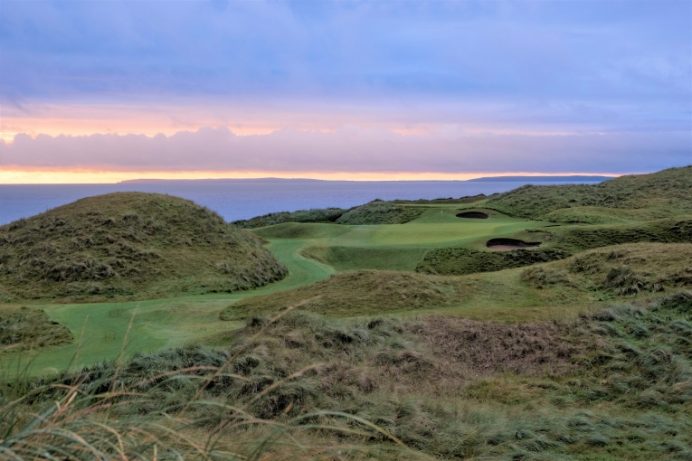
Ballybunion’s lunar landscape is evident even at sunset.
Sixteenth hole, 515 yards; Doglegs are a fabulous attribute in a windy site and Ballybunion finishes with three of them! They all bend from right to left but that’s their only similarity. The one here heads off in a southerly direction, seventeen to the west and eighteen to the east. As at thirteen, the tiger knows that a good drive here might be worth a full stroke. And here’s the thing at Ballybunion: the golfer is induced to give it a go because the angled fairway could be argued to be ~ 80 yards in width. Spectacular dunescapes at other courses like nearby Lahinch, Royal Country Down, or Royal St. George’s typically hem in the golfer as he tries to find the fairways between the dunes. Both here and the next hole, the diagonal nature of the fairway to the tee inspire the golfer to be cavalier and attacking. None other than Alister MacKenzie prized bold golf and it is a great pity that the legend himself never saw the final iteration of this design because there is no doubt that he would have cheered rapturously. With their lay-of-the-land architecture that includes back-to-back par fives on the front and back-to-back par threes on the back, Ballybunion and Cypress Point share more than a passing similarity. Neither course is long by today’s standard (both measure under 6,750 yards) but no player worth his salt has walked off either and said, ‘Gee, I wish the course was harder.’
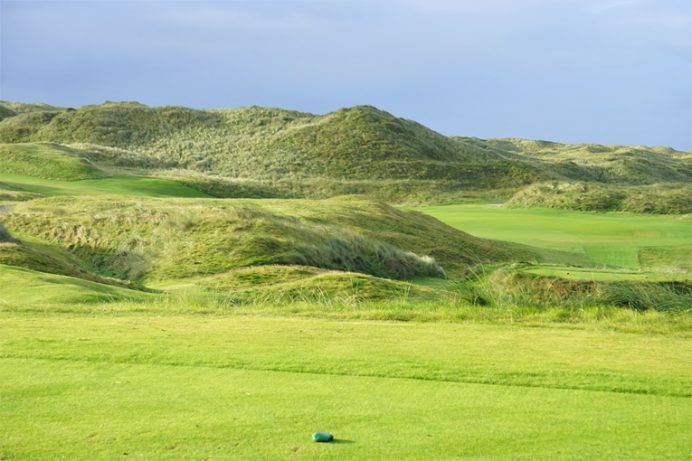
The angled 16th fairway extends right to left across the entire photograph.
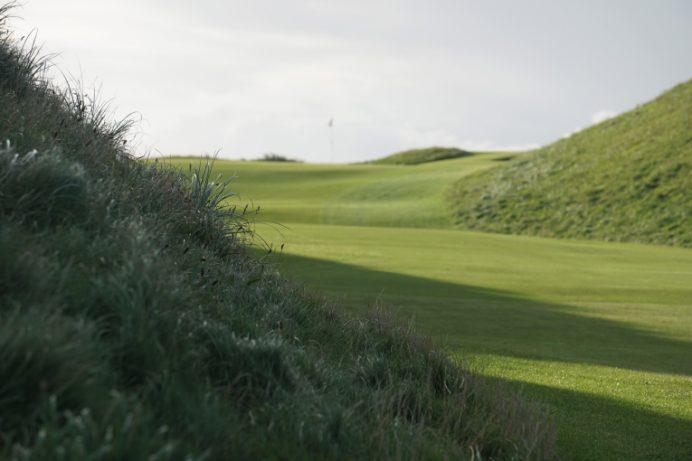
The second must be slotted between two dunes with the flag fluttering on the horizon.
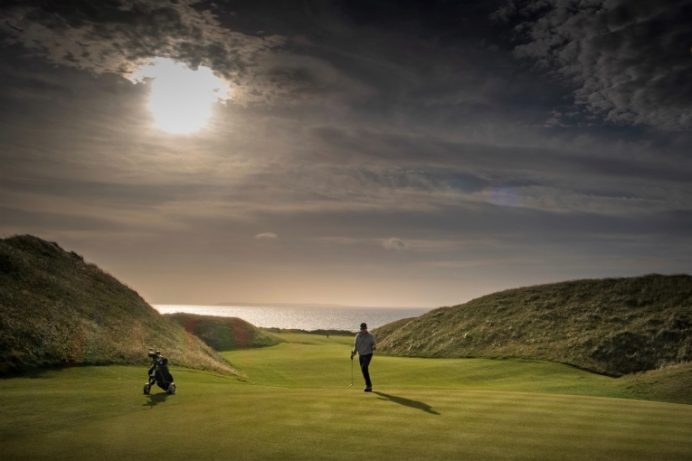
The view back down the 16th.
Seventeenth hole, 400 yards; The course offers several indelible moments, the last occurring here on the penultimate tee that Simpson recommended whereby the golfer aims at the Atlantic Ocean. To quote Simpson from his report, ‘Whatever you may decide touching green 11 [today’s 16th] , we strongly advise a new tee [for today’s #17] well away to the left of existing green 11 on the site we pointed out to you. You simply cannot pass by this great and glorious chasm, which is calling out for a tee shot to be played across it. No alteration to the green which is ideal from every point of view.’ The conspicuous sight of the water – often times, awe-inspiring – is another differentiator to most other world class links. The distant churning waves lift a man’s spirit from his mundane, daily concerns but he needs to gather himself quickly to play the proper shape shot off the tee.

Fairway bunkers aid an architect in lending good golf qualities to holes where the land doesn’t do so. Case in point, they were liberally applied at the par 5 4th and 5th holes. Meanwhile, only one (!) fairway bunker was required on holes 6, 7, 9, 10, 11, 16, and 17. The sole one is actually here, though out-of-sight on the inside of the dogleg.

County Kerry is known for its spectacular beaches. This view to the north from the outside of the dogleg 17th also captures the seawall that the club carefully erected to preserve the hole.
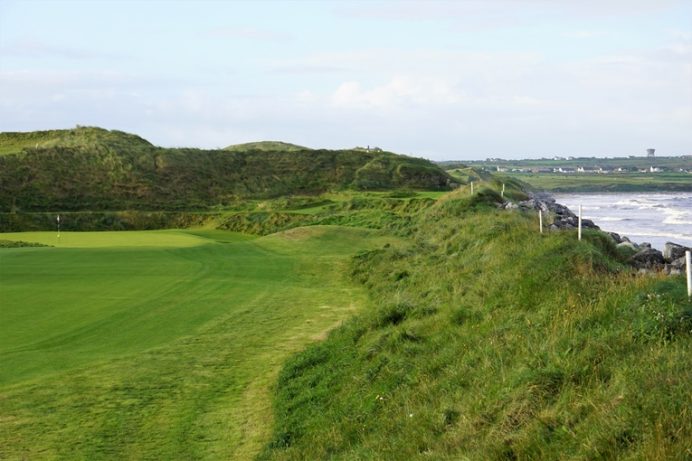
Turning to the south, the green is attractively nestled in its own amphitheatre.
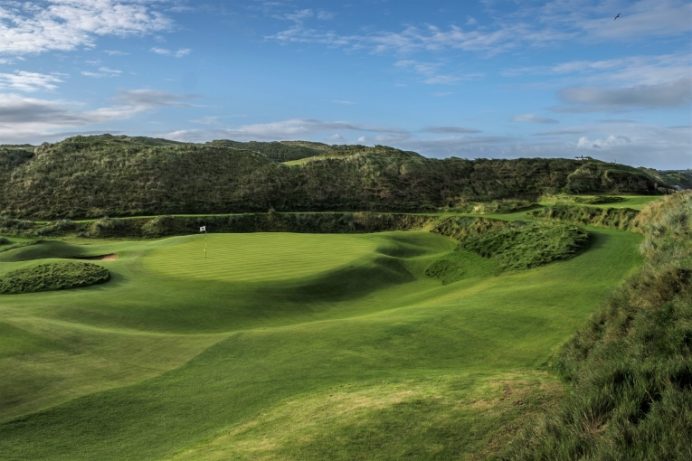
Ballybunion is the rarest of rare instances whereby the dunes are equally good on a macro and micro level. Off the tee on a macro level, the scale of the dunes is breathtaking. Close to the green on a micro level, a slight rise in the fairway 15 yards shy of the green creates an unseen gulley/channel that makes depth perception problematic and recovery shots fascinating.
In 1971, land was purchased directly south of the Old Course for the Cashen course. As part of doing so, the clubhouse was moved south some 1,500 yards so that play could commence at both courses from a central location. That’s when today’s sequence of holes was established for Ballybunion Old. Not that it should matter what sequence you play the holes – after all, the holes are the holes – but at Ballybunion Old it does. The inland holes are gobbled up early in the round and the golfer goes on a thrill ride from six in that leaves him panting for more. As an aside, the author admirers the back-to-back par 5s at four and five from a design perspective as the pair of long holes eat up the less interesting land plus both are capped off by really fine (and underrated) green complexes.
Parts of the round feel like a grand adventure but there are enough quiet moments mixed in with the holes across heaving land to where the golfer is never overwhelmed. The land is the star with the refined green complexes adding in sophistication as required. Man-made features (a.k.a. bunkers) play less of a role than they do at comparable excellent designs like Oakmont and Riviera. With land this good, man needed to show restraint and mercifully that is what happened. Such is rarely the case when a course is built over decades by committee but in many moments of wisdom down through the years, it happened here. Throw in the wind – and now true links conditions – and you have a playing experience that exudes the best virtues that the sport offers. No golfer’s education is complete without playing here. As Herbert Warren Wind said those many years ago, Ballybunion is ‘profoundly exciting.’

This look back down the Home hole prompts one thought: When can I play here again?!

